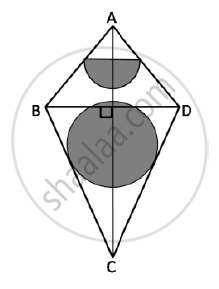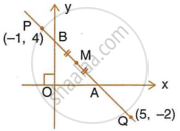Advertisements
Advertisements
Question
P(3, 4), Q(7, –2) and R(–2, –1) are the vertices of triangle PQR. Write down the equation of the median of the triangle through R.
Solution
Let median through R be RX.
We know that, the median, RX through R will bisect the line PQ.
By Mid-point formula,
Mid-point = `((x_1 + x_2)/2, (y_1 + y_2)/2)`
The co-ordinates of point X are
`((3 + 7)/2, (4 +(-2))/2)`
= `(10/2, 2/2)`
= (5, 1)
By formula,
Slope = `(y_2 - y_1)/(x_2 - x_1)`
Substituting values we get,
Slope of RX = `(1 - (-1))/(5 - (-2)) = 2/7`
Then, the required equation of the median RX is given by
`=>` y − y1 = m(x − x1)
`=> y - (-1) = 2/7[x - (-2)]`
`=> y + 1 = 2/7(x + 2)`
`=>` 7(y + 1) = 2(x + 2)
`=>` 7y + 7 = 2x + 4
`=>` 7y = 2x – 3
Hence, equation of the median through R is 7y = 2x – 3.
APPEARS IN
RELATED QUESTIONS
The given figure represents a kite with a circular and a semicircular motifs stuck on it.
The radius of a circle is 2.5 cm and the semicircle is 2 cm. If diagonals AC and BD are
of lengths 12 cm and 8 cm respectively, find the area of the:
1) Shaded part. Give your answer correct to the nearest whole number.
2) Unshaded part

Use graph paper for this question (Take 2 cm = 1 unit along both x and y-axis). ABCD is a quadrilateral whose vertices are A(2, 2), B(2, –2), C(0, –1) and D(0, 1).
1) Reflect quadrilateral ABCD on the y-axis and name it as A'B'CD
2) Write down the coordinates of A' and B'.
3) Name two points which are invariant under the above reflection
4) Name the polygon A'B'CD
Using a graph paper, plot the points A(6, 4) and B(0, 4).
- Reflect A and B in the origin to get the images A' and B'.
- Write the co-ordinates of A' and B'.
- State the geometrical name for the figure ABA'B'.
- Find its perimeter.
A straight line passes through the points P(–1, 4) and Q(5, –2). It intersects the co-ordinate axes at points A and B. M is the mid-point of the segment AB. Find:

- The equation of the line.
- The co-ordinates of A and B.
- The co-ordinates of M.
(1, 5) and (–3, –1) are the co-ordinates of vertices A and C respectively of rhombus ABCD. Find the equations of the diagonals AC and BD.
A line through origin meets the line x = 3y + 2 at right angles at point X. Find the co-ordinates of X.
Point A and B have co-ordinates (7, −3) and (1, 9) respectively. Find:
- the slope of AB.
- the equation of perpendicular bisector of the line segment AB.
- the value of ‘p’ of (−2, p) lies on it.
Use a graph sheet for this question.
Take 1 cm = 1 unit along both x and y axis.
(i) Plot the following points:
A(0,5), B(3,0), C(1,0) and D(1,–5)
(ii) Reflect the points B, C and D on the y axis and name them as B',C'andD' respectively.
(iii) Write down the coordinates of B',C 'and D'
(iv) Join the point A, B, C, D, D ', C ', B', A in order and give a name to the closed figure ABCDD'C'B
Use a graph sheet for this question, take 2 cm = 1 unit along both x and y-axis:
- Plot the points A (3, 2) and B (5, 0). Reflect point A on the y-axis to A΄. Write co-ordinates of A΄.
- Reflect point B on the line AA΄ to B΄. Write the co-ordinates of B΄.
- Name the closed figure A’B’AB.
